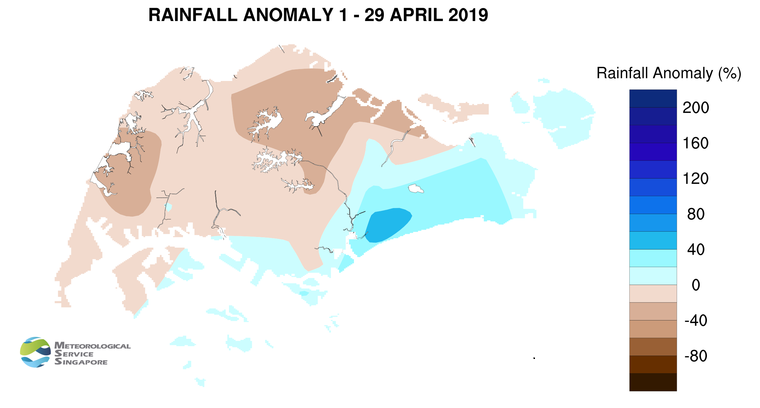Inter-monsoon conditions to persist in the next fortnight. Expect mostly short-duration afternoon thundery showers & 3-5 mornings of widespread showers with gusty winds. Expect warm conditions with daily max temperatures of 34°C or more.
Fortnightly Weather Outlook for 30 April – 15 May 2019
Singapore, 30 April 2019 – Inter-monsoon conditions have been prevailing since late March 2019 and are forecast to continue into May 2019. During this period, more occurrences of thundery showers can be expected over Singapore and the surrounding region, and the low level winds are forecast to be light and variable in direction. Climatologically, May has one of the highest number of lightning days in the year; May is also one of the warmest months of the year.
2 In the first half of May 2019, strong solar heating of land areas during the day are expected to bring short-duration moderate to heavy thundery showers in the afternoon on four to six days. On a few of these days, the thundery showers could extend into the evening. In addition, on three or five days, particularly in the second week of the fortnight, Sumatra squalls could bring widespread thundery showers with gusty winds in the predawn and morning. Overall, the rainfall for the first half of May 2019 is likely to be near-normal over most parts of Singapore.
3 Warm conditions to continue into the fortnight. On most days, the daily temperature is forecast to range between 25°C and 34°C. On a few days, the heat can be sweltering as the daily maximum temperature could reach around the high end of the 35°C range when there is little or no rainfall.
4 For updates of the daily weather forecast, please visit our MSS website (https://www.weather.gov.sg), NEA website (www.nea.gov.sg), or download the myENV app, or the MSS’ Weather@SG app.
REVIEW (1 – 29 April 2019)
5 Inter-monsoon conditions with low level winds that were light and variable in direction prevailed over Singapore and the surrounding region in April 2019. During the month, the presence of the monsoon rain band over the equatorial region contributed to more thundery showers over Singapore and the surrounding region, compared to March 2019.
6 In April 2019, thundery showers fell over the island in the afternoon on most days, and extended into the evening on a few of these days. This was due to strong solar heating of land areas and light winds over Singapore and the surrounding vicinity. The eastward passage of Sumatra squalls on a few days brought widespread moderate to heavy thundery showers and gusty winds to Singapore in the predawn and early morning. In particular, on 26 April 2019, the Sumatra squall over Singapore between the late morning and afternoon recorded a daily total rainfall of 118.7mm at Changi. This was the highest rainfall recorded in a day in April 2019.
7 April 2019 was also particularly warm. More than half the month had daily maximum temperatures exceeding 34°C. The highest daily maximum temperature of 36.4°C was recorded at Paya Lebar on 17 April 2019. This is close to the highest ever recorded daily maximum temperature of 37°C (1983) for April since temperature records started in 1929.
8 More than two-thirds of Singapore received slightly below-normal rainfall in April 2019. Rainfall was lowest at Seletar where 143.2 mm (36% below average) of rain was recorded. The highest rainfall of 299.8 mm (53% above average) was recorded over the south-eastern part of the island at Tanjong Katong.
CLIMATE STATION STATISTICS
Long-term Statistics for May
(Climatological reference period: 1981 – 2010)
| Average daily maximum temperature | 32.2 °C |
| Average daily minimum temperature | 25.4 °C |
| Average monthly temperature | 28.3 °C |
| Average rainfall | 171.2 mm |
| Average number of rain days | 14 |
Historical Extremes for May
(Rainfall since 1869 and temperature since 1929)
| Highest monthly mean daily maximum temperature: | 33.6 °C (1997) |
| Lowest monthly mean daily minimum temperature: | 23.5 °C (1974) |
| Highest monthly rainfall ever recorded: | 386.6 mm (1892) |
| Lowest monthly rainfall ever recorded: | 41.6 mm (1997) |

